New & Noteworthy
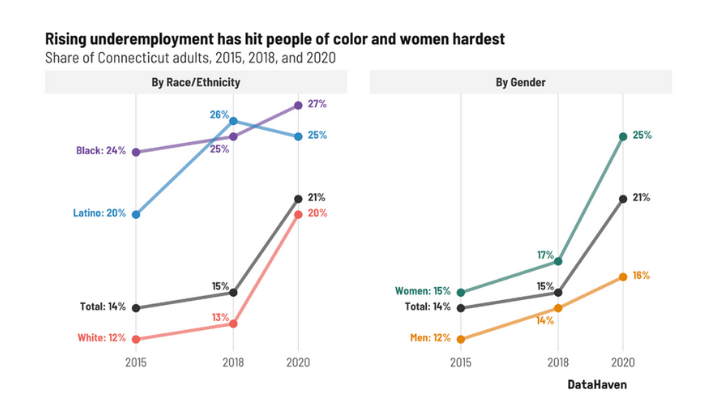
New DataHaven Survey Provides Reliable Information to Help Connecticut Communities Understand the Impacts of COVID-19
In-depth interviews with over 1,100 randomly-selected residents reveal how daily experiences differ by age, gender, race, and geographic area
*** DETAILED SURVEY DATA NOW AVAILABLE AT CTDATAHAVEN.ORG/WELLBEINGSURVEY ***
NEW HAVEN, CT – Today, DataHaven released a comprehensive dataset and new analyses from the fourth wave of its DataHaven Community Wellbeing Survey (DCWS). Considered to be one of the largest community health and quality of life surveys in the United States, the DCWS has provided Connecticut with consistent statistics about health, economic security, and social issues since 2012, based on approximately 35,000 live, in-depth interviews conducted in partnership with the Siena College Research Institute.
The latest results, released today by DataHaven, are based on live interviews of 1,108 Connecticut adults conducted between July 27 and August 18, 2020. The DCWS provides reliable estimates for the state as well as for residents grouped by characteristics such as age, gender, race/ethnicity, income, and the “Five Connecticuts” town type.1The program is unique due to its focus on Connecticut neighborhoods and range of questions within a single survey.
In response to the COVID-19 pandemic, the most recent wave of the DCWS included questions about social distancing, access to testing, vaccination, workplace safety, trust in institutions, and the impacts of the pandemic on residents’ health care and economic security.
“The purpose of the DataHaven Community Wellbeing Survey is to produce the most accurate, locally-relevant information on issues that are most meaningful to residents, thereby adding to what public agencies are able to collect through administrative record-keeping systems,” said Mark Abraham, Executive Director of DataHaven. “As many families face new challenges related to the coronavirus pandemic’s impact on the economy, health system, and society at large, it is encouraging that so many organizations are continuing their collaboration to collect information that truly represents the voices of residents throughout the state.”
Seeing the potential impact of its results, more than 80 public and private agencies throughout the state have funded the DCWS, including most of Connecticut’s leading hospitals, community foundations, and local health departments. Funders of the fourth wave of the survey released today include the Community Foundation for Greater New Haven, Tufts Health Plan Foundation, Connecticut Health Foundation, Hartford Foundation for Public Giving, United Way of Central and Northeastern Connecticut, Nuvance Health, City of Hartford, Trinity Health of New England, Valley Community Foundation, Greater Waterbury Health Partnership, BJM Solutions, and the Center for Research and Engagement at Yale School of Medicine. The questionnaire was developed by DataHaven and the Siena College Research Institute, with input gathered by DataHaven from 125 advisory council members, plus a Research Advisory Committee of survey experts from the University of Connecticut, Yale University, Drexel University, Siena College, and several area health departments.
“The unprecedented challenges of 2020 demand an unprecedented response from those of us who are committed to our community and its people. Because COVID-19 is so unique, and therefore comes with unforeseen impacts, the DataHaven information is particularly valuable to us as we seek to understand how these dynamics are reshaping life in our community. We will use this data to educate ourselves and the larger community about where the needs are greatest and how to best direct energy and resources to addressing the dual pandemics of COVID-19 and racial inequity,” said The Community Foundation for Greater New Haven President and CEO Will Ginsberg.
“The data from Connecticut illustrate markedly the socioeconomic and racial/ethnic disparities within the COVID-19 experience. Persons of color report work outside the home more often than whites, thereby being more likely to be exposed to community transmission. Black adults are more likely to know someone who has died of COVID-19 and are understandably more concerned about household transmission than are others. Latinx workers are more likely to have lost their jobs or to have been furloughed than others. COVID-19, therefore, mimics disparities seen in many other community-acquired infectious diseases such as influenza. DataHaven’s survey findings corroborate conclusions drawn from other sources, confirming the disproportionate burden of COVID-19 on minority communities. Given how vital public cooperation is for pandemic control, it was gratifying that confidence in officials from healthcare, state and local government, or police was high,” said Sten Vermund, Ph.D., Dean of the Yale School of Public Health.
About the Survey Results
As with other scientific surveys, all results are based on weighting the individual interview records by age, gender, reported race/ethnicity, geography, and telephone ownership to be statistically representative of the entire adult population in Connecticut. Weighted estimates for all questions are provided in the survey crosstabs, which are attached to this press release or available at ctdatahaven.org/wellbeingsurvey. For the overall sample of 1,108 Connecticut adults, these weighted estimates from the survey carry a “maximum” margin of error of +/- 3.8 percent with a 95 percent confidence interval, including the design effects resulting from weighting.2 For this reason, the differences in estimates between demographic groups that may be apparent from the crosstabs are not automatically considered statistically significant, though are often considered meaningful upon further review of available data. Please contact DataHaven with any questions.
Selected Survey Findings
QUALITY OF LIFE DURING THE COVID-19 PANDEMIC
● Despite the COVID-19 pandemic, 68% of adults in Connecticut report feeling mostly or completely happy during the previous day. However, this measure varied widely by income, ranging from 54% among adults earning less than $30,000 per year to 76% among adults earning $100,000 or more. The DataHaven Community Wellbeing Survey allows researchers to combine several measures of well-being with other items in the survey, in order to study the wide variety of factors – such as food and housing insecurity – that may have the greatest impact on the quality of life of Connecticut residents. Some factors that impact the well-being of Connecticut include:
o Since February 2020, 20% of all adults (including 18% of white, 22% of Black, and 37% of Latino adults) report that at least one adult in their household has lost their job or been laid off. Twenty-nine percent (29%) of all adults have had their work hours reduced or have been placed on a temporary furlough.
o Many in Connecticut struggle to afford food and housing, with 12% of men and 15% of women reporting food insecurity, meaning that they did not have enough money to buy food for themselves or their family at some point during the past year. Food insecurity ranged from 9% among white adults to 22% and 27%, respectively, among Black and Latino adults.
o Ten percent (10%) of all adults reported that they did not have enough money to provide adequate housing for themselves or their family in the past year. In 2018, the DataHaven Community Wellbeing Survey estimated this percentage at 8%, suggesting that difficulty covering costs may have risen during the COVID-19 pandemic despite the introduction of several policies designed to assist households facing housing insecurity.
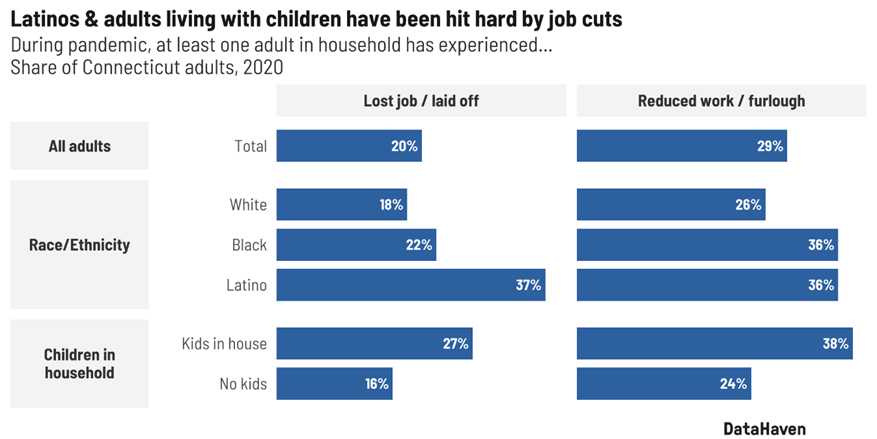
o Since February, 40% of adults living with children (including 34% of men and 47% of women) say that their family has found it more difficult than usual to handle child care responsibilities. Among adults living with children who are also working full-time, 37% of men and 59% of women reported that they have found it more difficult than usual.
o Twenty-one percent (21%) of the Connecticut workforce is considered underemployed, meaning that they have no job and would like to work, or they are currently working part-time but would prefer to have a full-time job. Compared to the 2018 DataHaven Community Wellbeing Survey, which measured the statewide underemployment rate at 15%, this represents an increase. Underemployment rates rose from 14% to 16% among men, and an alarming 17% to 25% among women during that time. By town type, underemployment rates varied from 18% in wealthy and suburban towns to 27% in the state’s large city centers. Approximately one-quarter of all adults are retired, disabled, or otherwise not in the workforce, so are not considered in these calculations.
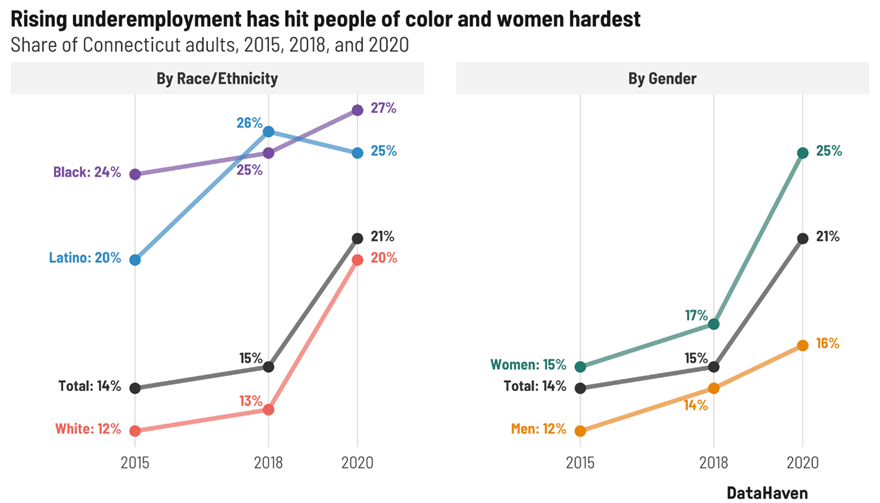
o Twenty-four percent (24%) of Connecticut residents say that they are either just getting by or finding it difficult or very difficult to get by when asked how they are managing financially. This varies by recent experience, as 44% of adults who have experienced the loss of a job in their household since February report that they are just getting by or finding it difficult to get by, compared to 20% of adults who have not experienced the loss of a job. Additionally, 55% of Black adults in Connecticut report they are just getting by or finding it difficult to get by, a significantly higher rate than other groups.
HEALTH AND SOCIAL DISTANCING DURING COVID-19
● Since February, 33% of Connecticut adults say that they had close friends or family who tested positive for COVID-19, 18% say they had close friends or family who were hospitalized for COVID-19, and 13% say they had close friends or family who died from COVID-19. The survey found that these rates were higher among Black and Latino communities in Connecticut.
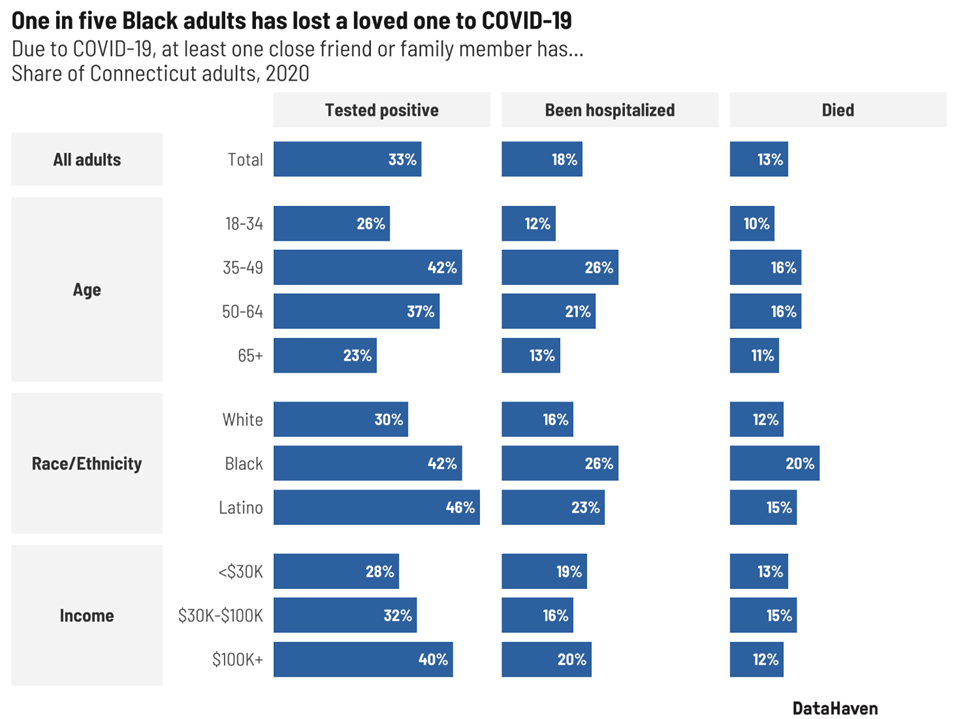
● During the past year, many Connecticut adults have found difficulty with access to health care. For instance:
o Since February 2020, 5% report that they or another adult in their household has lost their health insurance, including 4% of white, 8% of Black, and 11% of Latino adults.
o Nearly half have had to skip or postpone medical or dental care due to the pandemic. Out of those who had to skip or postpone care, 39% of lower-income adults and 15% of higher-income adults said that their condition got worse as a result.
o Since February, 6% of adults said they attempted to get a test but could not, and 20% said that they would have liked to get a test but did not seek one out. Among Latinos, those figures rise to 12% and 34%, respectively. Out of those adults who did not get a test when they attempted to or would have liked to, the most common reasons for not getting the COVID-19 test included not having symptoms (22%), which may have made some residents ineligible to receive a test, and not being able to get an appointment or find a site that was open (20%). Overall, 27% of adults report that they have been tested for COVID-19 at least once, including 8% who report that they were tested multiple times.
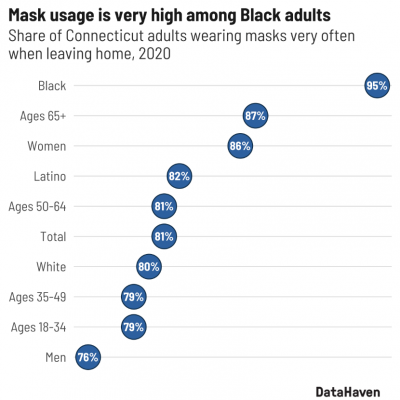
● When leaving their homes, 89% of Connecticut adults report that they are wearing a mask somewhat or very often. The percent of adults who say they are often wearing a mask varies from 81% in rural towns to 95% in the state’s city centers, from 88% among white adults to 97% among Black adults, and from 81% among adults who have completed high school or less to 93% among adults who have completed college.
o 12% of Connecticut adults reported that they worried other people might be suspicious of them if they wore a mask while in a store or business. Among Asian-Americans in Connecticut, an estimated 52% reported worrying about this.
● 91% of adults say that they could stay home for 14 days if they were exposed to and could possibly be infected with the coronavirus.
● 79% say that if someone in their household did have COVID-19, they would have access to a separate room for isolation. However, this figure varies widely by income, from 67% among households earning $30,000 or less to 88% among households earning $100,000 or more, as well as by age and race/ethnicity.
● 90% of adults are confident that they and their family members would be able to get the care they needed if they contracted COVID-19. Confidence in being able to access needed care is lower among Black adults in Connecticut, however; compared to white adults they are three times more likely to say that they are not very or not at all confident that they will be able to get the care they need.
● Overall, 91% of adults say they always, usually, or sometimes get the social and emotional support that they need. The proportion of adults who say that they only “rarely” or “never” get the support they need varies from 7% in wealthy and suburban towns to 15% in city centers, and from 4% among middle-aged adults age 50 to 64 to 15% among those adults age 80 and over.
WORKING DURING COVID-19
● Currently, 40% of Connecticut workers “very often” leave their home to go to work, while 31% of workers say that they “never” leave home. However, this varies throughout the state, with workers who are female, white, possessing a college degree, or earning a higher income being significantly more likely to report that they never leave home than other groups.
● Among working adults who leave the home at least on occasion, 60% are somewhat or very concerned about exposing themselves or their family to the coronavirus. 56% of white workers, 68% of Latino workers, and 82% of Black workers who leave the home for work are somewhat or very concerned about exposure.
o While concerns about exposure to COVID-19 are high in general, 87% of workers who leave home believe that their employer has done enough to ensure that employees are safe. Communities hit hardest by the pandemic have higher concerns about whether their employers have done enough to ensure safety, however.
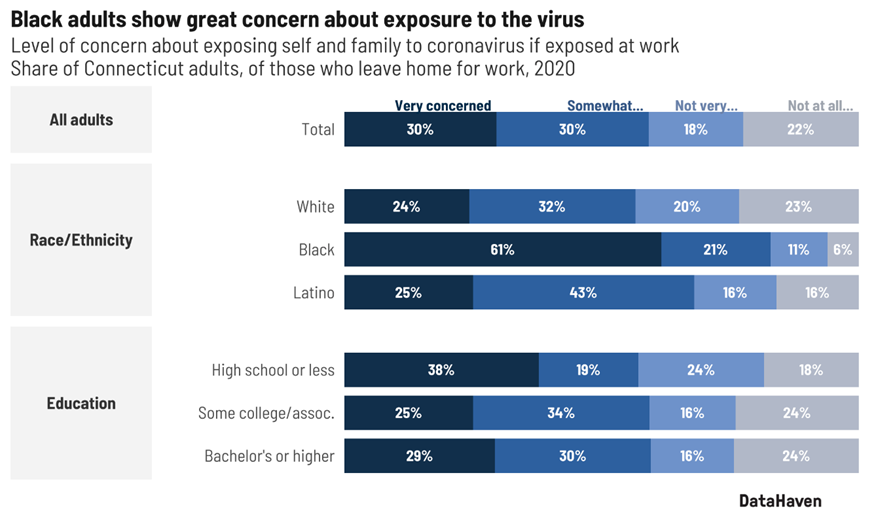
TRUST IN INSTITUTIONS AND A POTENTIAL COVID-19 VACCINE
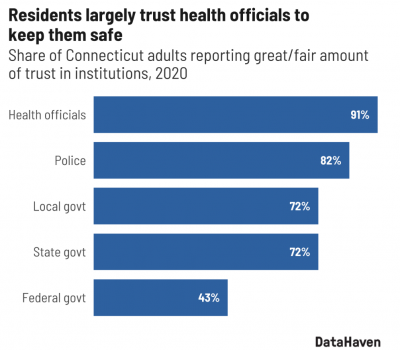
● Residents were asked how much trust they have in federal, state, and local government, as well as in local health officials and local police, to look out for the best interests of themselves and their families.
● Only 43% of adults said they had “a great deal” or “a fair amount” of trust in the Federal government to look out for their best interests. Meanwhile, the percentage of adults who said they had “a great deal” or “a fair amount” of trust was much higher for state government (72%) and for local government (also 72%). Although these levels of trust did not vary considerably across demographic groups, women reported significantly higher levels of trust in state and local government than men did, and white adults, adults with high income levels, and residents of wealthy or suburban towns reported higher levels of trust in their local government than other groups.
● Trust in local police was higher, with 82% of adults saying they had “a great deal” or “a fair amount” of trust in local police and law enforcement. When asked this question, 12% of adults said they had “not very much” trust, and 6% said “none at all.” Trust in local police varies by community, with younger adults, Black and Latino adults, and residents of city centers being 2 to 3 times more likely than older adults, white adults, and residents of wealthier towns to say that their level of trust in the police to look out for their best interests is “none at all.”
● Residents had the highest level of trust in local health officials and healthcare workers, with 91% of adults saying they had “a great deal” or “a fair amount” of trust in these workers to look out for their best interests. Trust in health officials and healthcare workers was somewhat lower among Black adults (81%) as compared to other groups.
● 63% of Connecticut adults say that if a vaccine against the coronavirus becomes available, they would plan to get vaccinated, while 20% say they would not and 17% are unsure. As has been found in recent national surveys, residents who identify as Black are significantly more likely to express hesitancy about a potential vaccine, with just 38% saying they would plan to get vaccinated, 40% saying they would not, and an additional 22% saying they are unsure. The issue of vaccine hesitancy has been the focus of recent news coverage in Connecticut.[3]
o Independent of race/ethnicity, residents who express limited trust in the institutions mentioned above are significantly less likely to say that they would get a vaccine when it becomes available; this relationship is particularly apparent among younger adults.
Next Steps
Over the coming weeks, DataHaven’s partner organizations and academic centers will continue analyzing the granular data from the DCWS in order to present recommendations for improving quality of life within Connecticut.
DataHaven staff have been presenting results to many local and statewide groups, and survey data were cited by Governor Ned Lamont in his press briefings last week.[4]
As part of its Powering Healthy Lives initiative, DataHaven recently released a four-part video series, COVID-19 Reckonings, produced by Purple States and DataHaven with residents of Connecticut communities hardest hit by the pandemic because of longstanding inequities, that uses recent survey and other data to illustrate the impacts of COVID-19. Data from the fourth wave of the DCWS will be incorporated into continuing film production with residents and community organizations this fall; learn more at ctdatahaven.org/video.
Area Leaders Comment on Survey Findings
“Last year the Hartford Foundation for Public Giving announced its strategic commitment to reduce the persistent racial/ethnicity, geographic and income disparities in order to ensure that Greater Hartford reaches its full potential as a vibrant, thriving and contributing force for regional and state prosperity. This survey illustrates how the COVID-19 public health and economic crises have exacerbated these disparities, reinforcing the urgent need to address the decades of systemic factors, structural racism and disinvestment in many of our communities that created these inequities,” said Hartford Foundation President Jay Williams.
“In keeping with our Mission and Core Values, Trinity Health Of New England is deeply committed to serve as a healing presence to our patients and our neighbors, which has become even more critical at this challenging time,” said Carlos Brown, Chief Diversity & Inclusion Officer, Community Health & Well Being, Trinity Health Of New England. “Before, during and well beyond the COVID-19 pandemic, we remain dedicated to providing access to equitable health care, regardless of an individual’s race or socioeconomic status. We are excited to be a partner in the valuable work done by DataHaven to ensure disparities are accounted for and addressed, and we are proud to stand along the many community partners striving to eliminate such disparities.”
According to Don Levy, Ph.D., Director of the Siena College Research Institute, “Working on behalf of DataHaven, we have developed the largest dataset of its kind – this survey offers an extensive look at the health, satisfaction, perception of neighborhood or community, access to medical care, economic strength, and personal safety of a representative sample of state residents, and includes robust samples by not only small geographic areas but also by age, race/ethnicity, education, and income. The dramatic impact of COVID-19 on all Connecticut residents, but especially how those impacts vary by race and ethnicity, income, and wealth, are demonstrated in this special survey. This project, like the extensive DataHaven dataset, provides Connecticut service providers with important insights.”
[3] For example, see NEPM article, https://www.nepm.org/post/black-church-leaders-react-covid-19-vaccine-comments.
[4] See CT Mirror article, https://ctmirror.org/2020/09/09/pfizers-groton-site-helped-develop-a-covid-19-vaccine-now-the-question-is-will-it-work/.
